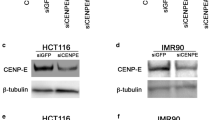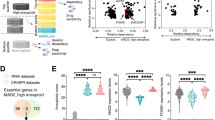Abstract
Purpose
The study aimed to investigate the role of spindle assembly checkpoint (SAC) in cancer cells with compromised genomic integrity. Chromosomal instability (CIN) gives cancer cells an adaptive advantage. However, maintaining the balance of this instability is crucial for the survival of cancer cells as it could lead them to the mitotic catastrophe. Therefore, cancer cells adapt to the detrimental effects of CIN. We hypothesized that changes in SAC might be one such adaptation mechanism. The focus of the study was BUB1B, an integral part of the checkpoint.
Methods
Clinical datasets were analyzed to compare expression levels of SAC genes in normal tissue vs. breast carcinoma. The effects of the reduction of BUB1B expression was examined utilizing RNA interference method with siRNAs. In vitro viability, clonogenicity, apoptosis, and SAC activity levels of a variety of breast cancer (BrCa) cell lines, as well as in vivo tumorigenicity of the triple-negative breast cancer (TNBC) cell line MDA-MB-468, were tested. Additionally, the chromosomal stability of these cells was tested by immunofluorescence staining and flow cytometry.
Results
In clinical breast cancer datasets, SAC genes were elevated in BrCa with BUB1B having the highest fold change. BUB1B overexpression was associated with a decreased probability of overall survival. The knockdown of BUB1B resulted in reduced viability and clonogenicity in BrCa cell lines and a significant increase in apoptosis and cell death. However, the viability and apoptosis levels of the normal breast epithelial cell line, MCF12A, were not affected. BUB1B knockdown also impaired chromosome alignment and resulted in acute chromosomal abnormalities. We also showed that BUB1B knockdown on the MDA-MB-468 cell line decreases tumor growth in mice.
Conclusions
A functional spindle assembly checkpoint is essential for the survival of BrCa cells. BUB1B is a critical factor in SAC, and therefore breast cancer cell survival. Impairment of BUB1B has damaging effects on cancer cell viability and tumorigenicity, especially on the more aggressive variants of BrCa.





Similar content being viewed by others
Data availability
The datasets generated during and/or analyzed during the current study are available from the corresponding author on reasonable request.
Abbreviations
- BrCa:
-
Breast cancer
- CIN:
-
Chromosomal instability
- ffluc:
-
Firefly luciferase
- MCC:
-
Mitotic checkpoint complex
- NSC:
-
Non-silencing control
- NSG:
-
NOD scid gamma
- PI:
-
Propidium iodide
- SAC:
-
Spindle assembly checkpoint
- TNBC:
-
Triple-negative breast cancer
References
Suijkerbuijk SJE et al (2010) Molecular Causes for BUBR1 Dysfunction in the Human Cancer Predisposition Syndrome Mosaic Variegated Aneuploidy. Can Res 70(12):4891–4900
Hyunsook L et al (2014) How Chromosome Mis-Segregation Leads to Cancer: Lessons from BubR1 Mouse Models. Mol Cells 37(10):713–718
Elowe S (2011) Bub1 and BubR1: at the Interface between Chromosome Attachment and the Spindle Checkpoint. Mol Cell Biol 31(15):3085–3093
Bolanos-Garcia VM, Blundell TL (2011) BUB1 and BUBR1: multifaceted kinases of the cell cycle. Trends Biochem Sci 36(3):141–150
Lara-Gonzalez P, Westhorpe FG, Taylor SS (2012) The Spindle Assembly Checkpoint. Curr Biolo 22(22):R966–R980
Baker DJ et al (2004) BubR1 insufficiency causes early onset of aging-associated phenotypes and infertility in mice. Nat Genet 36(7):744–749
Baker DJ, Chen J, van Deursen JMA (2005) The mitotic checkpoint in cancer and aging: what have mice taught us? Curr Opin Cell Biol 17(6):583–589
Wijshake T et al (2012) Reduced Life- and Healthspan in Mice Carrying a Mono-Allelic BubR1 MVA Mutation. PLoS Genet 8(12):e1003138
Morales A et al (2013) BUB1 and BUBR1 inhibition decreases proliferation and colony formation, and enhances radiation sensitivity in pediatric glioblastoma cells. Child's Nervous System 29(12):2241–2248
Ding Y et al (2013) Cancer-Specific requirement for BUB1B/BUBR1 in human brain tumor isolates and genetically transformed cells. Cancer Discov 3(2):198–211
Wan X et al (2012) Identification of FoxM1/Bub1b signaling pathway as a required component for growth and survival of rhabdomyosarcoma. Can Res 72(22):5889–5899
Kops G, Foltz D, Cleveland D (2004) Lethality to human cancer cells through massive chromosome loss by inhibition of the mitotic checkpoint. Proc Natl Acad Sci USA 101(23):8699–8704
Rhodes DR et al (2004) ONCOMINE: a cancer microarray database and integrated data-mining platform. Neoplasia 6(1):1–6
Dawson SJ et al (2013) A new genome-driven integrated classification of breast cancer and its implications. EMBO J 32(5):617–628
Chia SK et al (2012) A 50-gene intrinsic subtype classifier for prognosis and prediction of benefit from adjuvant tamoxifen. Clin cancer res : an official J Am Assoc Cancer Res 18(16):4465–4472
Győrffy B et al (2013) Online survival analysis software to assess the prognostic value of biomarkers using transcriptomic data in non-small-cell lung cancer. PLoS ONE 8(12):e82241
Freedman VH, Shin S-I (1974) Cellular tumorigenicity in nude mice: Correlation with cell growth in semi-solid medium. Cell 3(4):355–359
Musacchio A (2011) Spindle assembly checkpoint: the third decade. Philos Trans R Soc Lond B Biol Sci 366(1584):3595–3604
Leber, B., et al., 2010 Proteins Required for Centrosome Clustering in Cancer Cells. Sci Translational Med. 2(33): p. 33ra38.
Krämer A, Maier B, Bartek J (2011) Centrosome clustering and chromosomal (in)stability: a matter of life and death. Molecular oncology 5(4):324–335
Kwon M et al (2008) Mechanisms to suppress multipolar divisions in cancer cells with extra centrosomes. Genes Dev 22(16):2189–2203
Anders C, Carey LA (2008) Understanding and treating triple-negative breast cancer. Oncology 22(11):1233–1243
Baron AP et al (2016) Probing the catalytic functions of Bub1 kinase using the small molecule inhibitors BAY-320 and BAY-524. Elife 5:e12187
Siemeister G et al (2019) Inhibition of BUB1 Kinase by BAY 1816032 sensitizes tumor Cells toward Taxanes, ATR, and PARP inhibitors In vitro and in vivo. Clin Cancer Res 25(4):1404–1414
Stratmann JA, Sebastian M (2019) Polo-like kinase 1 inhibition in NSCLC: mechanism of action and emerging predictive biomarkers. Lung Cancer 10:67–80
Guo Y et al (2012) CENP-E–dependent BubR1 autophosphorylation enhances chromosome alignment and the mitotic checkpoint. J Cell Biol 198(2):205–217
Jablonski SA et al (1998) The hBUB1 and hBUBR1 kinases sequentially assemble onto kinetochores during prophase with hBUBR1 concentrating at the kinetochore plates in mitosis. Chromosoma 107(6):386–396
Neve RM et al (2006) A collection of breast cancer cell lines for the study of functionally distinct cancer subtypes. Cancer Cell 10(6):515–527
Drews-Elger K et al (2014) Primary breast tumor-derived cellular models: characterization of tumorigenic, metastatic, and cancer-associated fibroblasts in dissociated tumor (DT) cultures. Breast Cancer Res Treat 144(3):503–517
Goka ET, Lippman ME (2015) Loss of the E3 ubiquitin ligase HACE1 results in enhanced Rac1 signaling contributing to breast cancer progression. Oncogene 34(42):5395–5405
Cramer, L., A. Desai, and T. Mitchison. Fluorescence procedures for the actin and tubulin cytoskeleton in fixed cells. 2020; Available from: https://mitchison.hms.harvard.edu/files/mitchisonlab/files/fluorescence_procedures_for_the_actin_and_tubulin_cytoskeleton_in_fixed_cells.pdf.
Acknowledgements
We thank Kinga and Edward Scott Lampert for their generous gift to our lab; Sheila and David Fuente Graduate Program in Cancer Biology at the University of Miami for their guidance; Hanna Fiske, Kelsie Medina-Saenz, Jun Sun for their technical support; Patricia Lisette Guevara at the University of Miami SCCC Flow Cytometry Shared Resource and Pete Johnson at Georgetown University LCCC Microscopy & Imaging Shared Resource for their assistance and expertise; Merlyn Donatien for daily administrative assistance.
Funding
This study was funded by the departmental funds of the University of Miami, Sylvester Comprehensive Cancer Center and Georgetown University, Department of Oncology.
Author information
Authors and Affiliations
Contributions
DK and MEL contributed to the study conception and design. All authors contributed to the development of methodology. DK (all experiments) and US (animal studies) contributed to the data collection and analysis. The first draft of the manuscript was written by DK, and all authors commented on previous versions of the manuscript. All authors read and approved the final manuscript.
Corresponding author
Ethics declarations
Conflict of interest
The authors declare no conflict of interest.
Ethical approval
All applicable international, national, and/or institutional guidelines for the care and use of animals were followed.
Additional information
Publisher's Note
Springer Nature remains neutral with regard to jurisdictional claims in published maps and institutional affiliations.
Electronic supplementary material
Below is the link to the electronic supplementary material.
10549_2020_5962_MOESM1_ESM.pdf
Supplementary file1 (PDF 73 kb). Supplementary Fig 1 BubR1 protein levels at 60 days after inoculation in tumors transfected with NSC or siBUB1B (61 days after transfection).
Rights and permissions
About this article
Cite this article
Koyuncu, D., Sharma, U., Goka, E.T. et al. Spindle assembly checkpoint gene BUB1B is essential in breast cancer cell survival. Breast Cancer Res Treat 185, 331–341 (2021). https://doi.org/10.1007/s10549-020-05962-2
Received:
Accepted:
Published:
Issue Date:
DOI: https://doi.org/10.1007/s10549-020-05962-2




